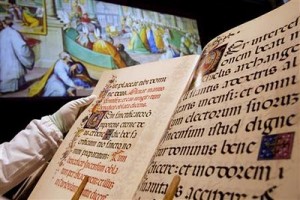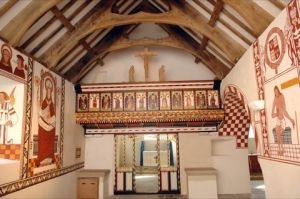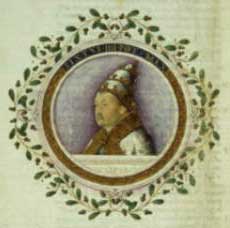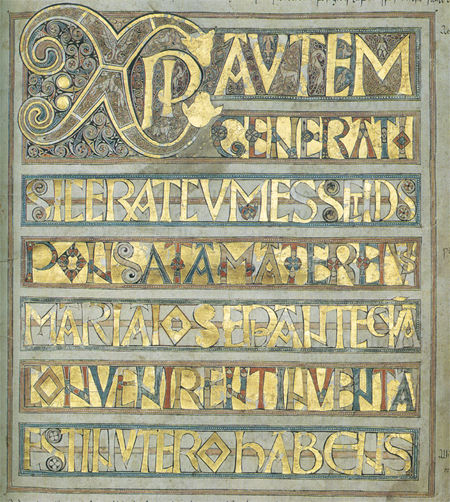Making Your Own Illuminations Part 1 – Let the Fun Begin
This is not going to be a series of tutorials on how to create illuminations as they were done in medieval times. This is going to be a descriptive tutorial on how to create the illusion of medieval writing and illuminations using modern papers and materials.
I recommend two reference books for our discussions.
1. The Bible of Illuminated Letters: A Treasury of Decorative Calligraphy [BIBLE OF ILLUMINATED LETTERS] [Spiral] This is a wonderful book that provides precise and detailed descriptions of how to replicate what the medievalists did. If you want a real challenge and are dedicated to learning the craft, this is the book for you.
2. Medieval Illuminators and Their Methods of Work This book has many examples of partially completed manuscripts that allow you to see exactly how pages were created. It has a small section early in the book that gives a concise description of what we know about materials, methods and technique.
To get the most out of these tutorials, I suggest you think of something you wish to write as an illuminated text and follow the process with me. I’m going to create a new header image for this site. I’ve chosen a model for my illumination. I’m going to style my illumination after the spectacular Codex Aureus from the eighth century. Here is my inspiration:
Think about what you want to do. It doesn’t have to be formal or fancy. It might be something as simple as a page in your art journal or sketchbook. In part 2, I’m going to discuss possible materials you might want to use for your illumination.
May 15, 2011 1 Comment
CBS News 60 Minutes Visits the Vatican Library
 I hope everyone stayed tuned to CBS after the Masters yesterday to watch 60 Minutes. They did a marvelous piece on the Vatican Library with Morely Safer as host. In case you missed it, video is available at CBS News.
I hope everyone stayed tuned to CBS after the Masters yesterday to watch 60 Minutes. They did a marvelous piece on the Vatican Library with Morely Safer as host. In case you missed it, video is available at CBS News.
April 11, 2011 Comments Off on CBS News 60 Minutes Visits the Vatican Library
The Recreation of a Medieval Organ at St. Fagans
 Here is a quick link to a very interesting project. A team has worked to recreate a medieval organ. None survived the reformation so they’ve faced enormous obstacles researching this project. A story on the BBC lets you hear a sound that has not been heard for centuries.
Here is a quick link to a very interesting project. A team has worked to recreate a medieval organ. None survived the reformation so they’ve faced enormous obstacles researching this project. A story on the BBC lets you hear a sound that has not been heard for centuries.
April 8, 2011 Comments Off on The Recreation of a Medieval Organ at St. Fagans
Enjoying the Filth of the Middle Ages from a Safe Smelling Distance
 First, a bit of an apology for having been away for so long but life does intrude. Next, a promise, we have tons of new images from books of hours for the gallery. We’ll be uploading them soon. Finally, we’re thinking of providing some video tutorials on recreating the lettering and art from medieval times with modern tools and materials for art journaling or other popular craft applications. We would appreciate your imput on this idea.
First, a bit of an apology for having been away for so long but life does intrude. Next, a promise, we have tons of new images from books of hours for the gallery. We’ll be uploading them soon. Finally, we’re thinking of providing some video tutorials on recreating the lettering and art from medieval times with modern tools and materials for art journaling or other popular craft applications. We would appreciate your imput on this idea.
In the medieval sanitation and recycling department, here is a fine list of why medieval London probably smelled worse than we can imagine from our place in time. From, The Telegraph, “Medieval London: 10 disgusting facts:”
1. The inhabitants of medieval London (human and animal) produced 50 tons of excrement a day.
2. In medieval London, there were no pavements – people had to walk on the bare earth. Except, unfortunately, it wasn’t bare earth – the ground was covered with the excrement of both people and animals, as well as animal entrails and rotting food.
To read the rest, follow this link.
April 5, 2011 2 Comments
The Vatican Library – The Pope’s Library
 Since the Pope is visiting, I thought I’d call attention to the Vatican Library Exhibit on the Library of Congress web site. It’s a very informative short history of Rome and the library with a gallery of book manuscripts including many that are illuminated. The history of the Vatican Library is a fascinating story and what book lover hasn’t imagined roaming those stacks and finding a long lost book? From the Library of Congress page:
Since the Pope is visiting, I thought I’d call attention to the Vatican Library Exhibit on the Library of Congress web site. It’s a very informative short history of Rome and the library with a gallery of book manuscripts including many that are illuminated. The history of the Vatican Library is a fascinating story and what book lover hasn’t imagined roaming those stacks and finding a long lost book? From the Library of Congress page:
The Vatican Library, in fact, became a center of the revival of classical culture known as the Renaissance. Its librarians were often distinguished scholars. Historians and philosophers, clerics and magicians visited the collections and borrowed books from them. By 1581, when the French writer Michel de Montaigne visited Rome, the treasures of the Vatican had become a mandatory stop on any well-informed traveller’s Roman itinerary. To his delight, Montaigne was shown ancient Roman and ancient Chinese manuscripts, the love letters of Henry VIII, and the classics of history and philosophy (many of which can be seen in this exhibition). Then, as now, the Vatican Library was one of the greatest in the Western world.
April 16, 2008 Comments Off on The Vatican Library – The Pope’s Library


